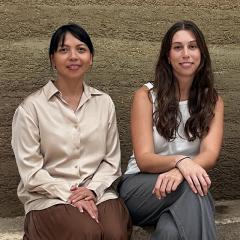Delegates from around the globe recently came together in Brisbane to explore the concept of “Islands” in architectural history and practice, at the 40th annual Society of Architectural Historians, Australia and New Zealand (SAHANZ) conference.
Co-convened by The University of Queensland and Queensland University of Technology, the conference was held 2–4 December 2024 across the Brisbane CBD campuses of the universities. It included 52 paper presentations, three roundtables, a panel discussion and social networking events, traversing a diverse range of topics, ideas and locations within the theme.
Co-convenors Dr Ashley Paine and Dr Kirsty Volz said the SAHANZ conference, the largest of its type in the region, gave members a valuable chance to present their research at all stages of development.
“The friendly atmosphere also made it an ideal opportunity for younger scholars to meet and get feedback on their work from more established academics,” said Dr Paine.
“The networking opportunities were a highlight, particularly the panel discussion on Careers in Architectural History and Heritage, which was held at the offices of BVN as a collaboration between EmAGN and SAHANZ.

Architectus Conrad Gargett, introducing EmAGN X SAHANZ panellists (L–R)
Fiona Gardiner, Professor Philip Goad, David Gole and Professor Hannah Lewi
at BVN Architecture Brisbane Studio.
Image credit: Dr Ashley Paine
“It was great to discuss how younger graduates might develop a career in history and heritage.”
More than 80 people attended the conference on the first day of proceedings, with delegates from as far as Madrid, Delft, Boston, Delhi and Lisbon. Several paper presentations looked back on the history of the Society, inspired by its 40th anniversary; some papers explored contrasts across political, social and cultural spheres that produce “islands of practice,” or siloes of discourse and debate; while others approached the “Islands” theme more literally.
Topics were diverse and wide-ranging, and included Indigenous trading exchanges across the Arafura Sea, the evolution of islands for the dead in Europe and Australia, the “Island-ness” of Hindu temples, the genesis of Sri Lankan tropical modernism, contemporary architectural heritage battles in Paramatta, social equity in evening public spaces, urban design in Brisbane through time, and ‘big things’ as road features, among many others.

held at the SAHANZ conference.
Image credit: Dr Ashley Paine
Macarena de la Vega, a lecturer at the Polytechnic University of Madrid and Honorary Fellow in the UQ School of Architecture, Design and Planning, has been a member of SAHANZ since 2015. She was a contributor in one of the roundtables, and said she was impressed with the diversity of topics at the conference and how well-paired the papers were.
“I particularly enjoyed those papers that dealt more literally with the theme, those set on the Pacific, specifically Papua New Guinea,” she said.
“Big highlights for me were the raw and moving presentation by Hannah Lewi, the always interesting new avenues that the research of Jasper Ludewig is opening, and Joss Kiely’s consistent engagement with the conference and the Society, travelling from the United States.”

in The Atrium at UQ Brisbane City.
Image credit: Dr Ashley Paine
The Society of Architectural and Urban Historians Asia (SAUHA) roundtable, titled “Oceanic Networks and Connections,” approached the subject of islands through their roles in regional oceanic networks and connections, focusing on the Southern Oceans in both geographical and political senses. From this oceanic perspective, the roundtable discussed architectures and urban environments in ways that can transcend national imaginaries to consider Asian/Indo-Pacific regions as a geographical continuum.

Image credit: Dr Ashley Paine
The Architecture, Theory, Culture, History (ATCH) roundtable, titled “The Uses and Abuses of History, Then and Now,” was convened by Professor John Macarthur and reflected on the value of architectural history research. It explored ways that politically progressive work in this field is de-colonising and de-masculinising the university curriculum as a path to a more ethical profession, and how this sits with the emphasis of governments and the university sector on the utility of research. It asked: “As the profession itself undergoes transformation, how should we reflect on the uses of history in the past, today, and into the future?”
The third roundtable was based on a forthcoming book edited by two of the roundtable members, titled Instituting Worlds: Architecture and Islands. This session, convened by Catharina Gabrielsson, reflected on the contributions that architecture may make to the interdisciplinary field of island studies, and, conversely, what architecture may learn from a field that arguably sits at the frontline of the humanities and social sciences. Drawings on insights from chapters of the book, the panel discussed how the engagement with islands has generated a diversity of methods, employed a broad scope of sources, and multiplied the agency of architecture, far beyond the boundaries of the physical building.

ATCH (Architecture, Theory, Culture, History)
Roundtable: The Uses and Abuses of History, Then and Now.
Image credit: Dr Ashley Paine
Another key highlight of the conference was the announcement of two new Life Members of SAHANZ: Associate Professor Ursula de Jong from Deakin University and Associate Professor Julia Gatley from the University of Auckland, Waipapa Taumata Rau.
Dr Volz said it was wonderful having UQ and QUT work together on the conference as shared hosts.
“It was a really lovely opportunity to welcome international guests to Brisbane. One delegate commented on how special it is that Brisbane universities occupy heritage buildings in the CBD, including UQ and QUT,” she said.
“We are actively contributing to maintaining Brisbane’s heritage as institutions, which is a generous thing to do.”
For more information about the conference and its papers visit the SAHANZ website.
In remembrance
In memory of Emeritus Professor Gevork Hartoonian, a most esteemed scholar and valued member of the editorial board of the Society of Architectural Historians, Australia and New Zealand. Professor Hartoonian was unable to attend the conference due to illness and sadly passed away on 20 December 2024. His contributions to the field of architectural history and his legacy of scholarship will be deeply missed.



